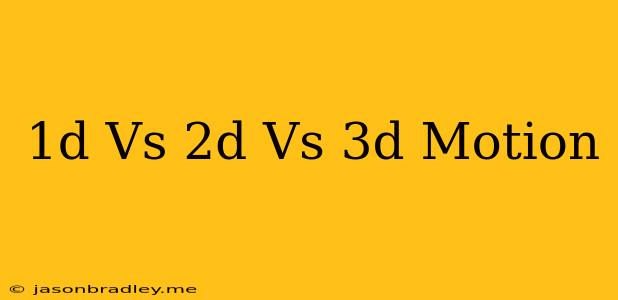Here is an article about 1D, 2D, and 3D motion:
Understanding the Dimensions of Motion: 1D, 2D, and 3D
Motion is a fundamental aspect of our physical world. From the simple act of walking to the complex movements of celestial bodies, understanding how objects move is crucial in various fields like physics, engineering, and animation. One way to analyze and classify motion is by its dimensionality. Let's delve into the distinctions between 1D, 2D, and 3D motion:
1D Motion: A Straight Line Journey
One-dimensional motion, as the name suggests, occurs along a single straight line. This motion can be visualized as a movement along a number line where the position of the object is defined by a single coordinate. Examples of 1D motion include:
- A car moving along a straight highway: The car's motion can be described by its position along the highway at any given time.
- A ball dropped vertically: The ball's motion can be described by its height above the ground.
- A pendulum swinging back and forth (assuming only the arc length is considered): The pendulum's motion can be described by its position along the arc at any given time.
1D motion is the simplest form of motion, as it only considers the object's position along a single axis. This simplification allows for easy analysis and calculation using basic equations of motion.
2D Motion: Exploring the Plane
Two-dimensional motion involves movement in a plane, meaning that the object's position is defined by two coordinates. Imagine a tabletop where a marble rolls across the surface. The marble's position can be described by its x-coordinate (horizontal position) and y-coordinate (vertical position). Other examples of 2D motion include:
- A projectile launched at an angle: The projectile's motion can be described by its horizontal and vertical positions over time.
- A fly buzzing around a room: The fly's movement can be represented by its x and y coordinates within the room.
2D motion introduces complexity compared to 1D motion, as it requires considering both the x and y components of the object's velocity and acceleration.
3D Motion: Embracing the Real World
Three-dimensional motion describes the movement of an object in space, requiring three coordinates to define its position. This is the most realistic representation of motion, as we live in a 3D world. Examples of 3D motion include:
- A bird flying in the air: The bird's motion requires three coordinates (x, y, and z) to describe its position in space.
- A planet orbiting the sun: The planet's motion requires three coordinates to describe its position in relation to the sun.
3D motion is the most complex type of motion, as it involves analyzing and calculating the object's motion in all three dimensions. This often requires advanced mathematical tools and computational methods.
Summary:
| Dimension | Description | Examples |
|---|---|---|
| 1D | Motion along a straight line | Car on a highway, ball dropped vertically |
| 2D | Motion in a plane | Projectile launched, fly buzzing around a room |
| 3D | Motion in space | Bird flying, planet orbiting the sun |
The choice of using 1D, 2D, or 3D motion depends on the specific problem or application. Simpler systems can be effectively modeled using 1D or 2D motion, while complex scenarios often require 3D analysis for accurate representation.
